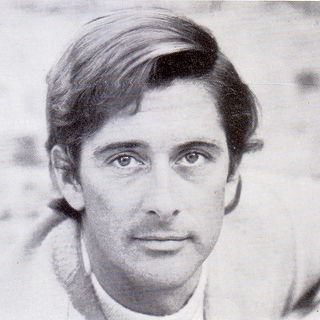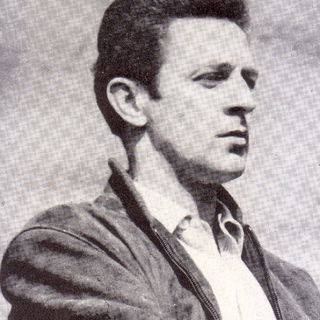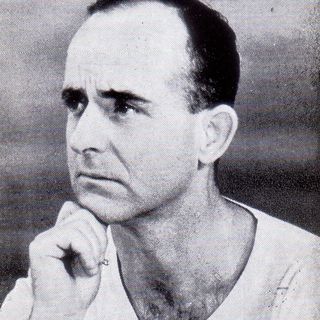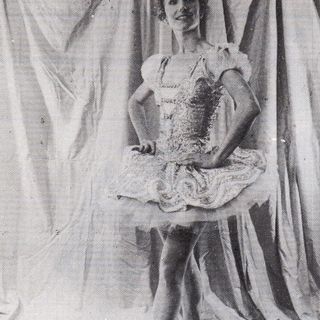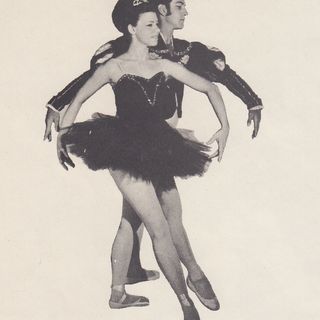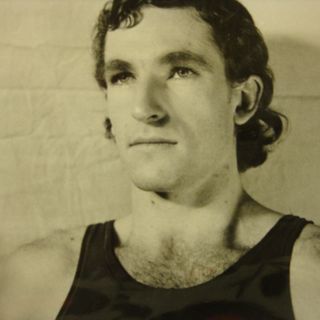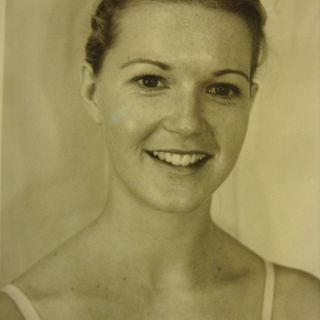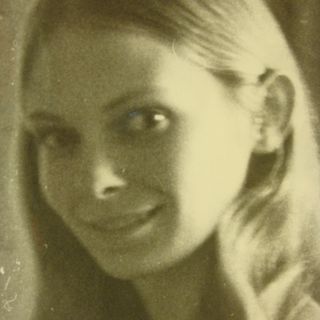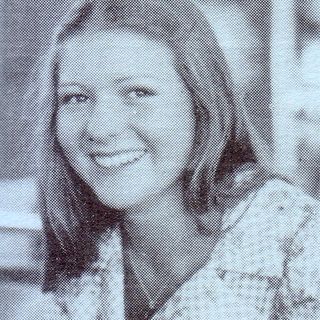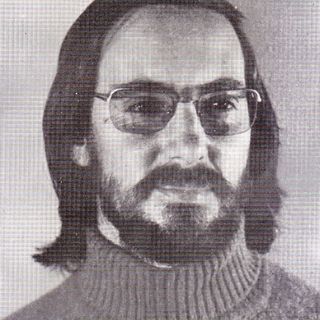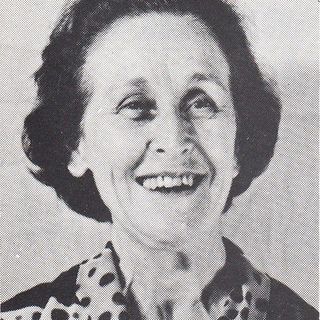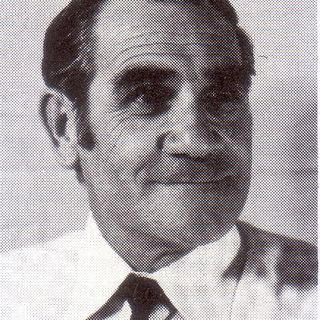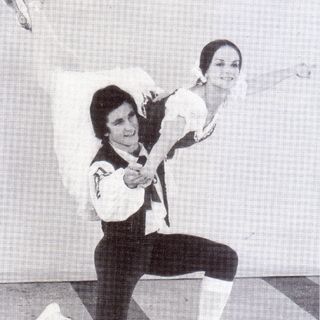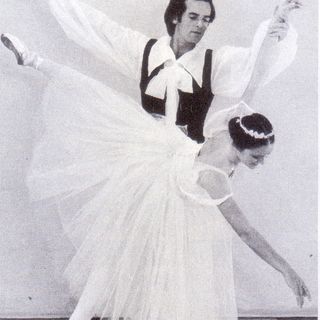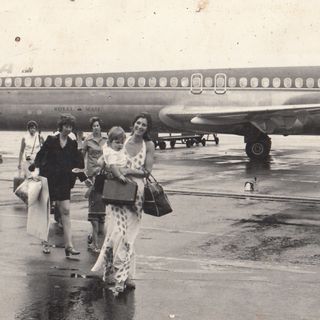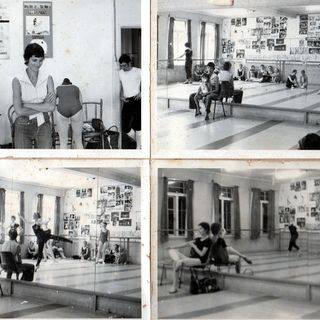
The 1970s
The decade of the 1970s began on an artistic high. Guest artists Marilyn Jones and Garth Welch from the Australian Ballet starred in BTQ’s Season of Ballet at Her Majesty’s Theatre. In an ambitious program that included Cinderella and Les Patineurs, the couple thrilled the audience with their Flower Festival in Genzano pas de deux and Esmeralda pas de deux.
Constance Cummins, ballet critic for the Courier-Mail, reported glowingly on the season under the “distinguished direction of Phyllis Danaher”. She wrote:
It was fitting that the Australian ballet’s premier danseur, Garth Welch, who had his early lessons from Miss Danaher, should give lustre to the occasion by appearing with his wife, prima ballerina Marilyn Jones.
Her exquisite line and balance, and astonishingly high arabesque were seen to advantage in the “Flower Festival” pas de deux, a buoyant display of allegro dancing, which demanded great flexibility. (The Courier-Mail, 2 April 1970)
The company continued to excel in its second ambitious programme for 1970 which included Les Sylphides, Divertissements from The Sleeping Princess, Danse Jeune and Le Beau Danube. Constance Cummins in her review likened it to a Borovansky Ballet evening of dance, commenting that Borovansky himself would certainly “have approved of the choice of items, and the style and enthusiasm of the dancers who took part in the performance ...” (The Courier-Mail, 28 October 1970)
Garnering praise in this review were Lexie Kunze, Mal Czislowski, Inara Svalbe, Judith Lowe, Desley Hammond, Peter Lucas, Dayne Cory and Evan Jones. Under the expert guidance of artistic director Phyllis Danaher, this group of talented dancers performed as soloists in BTQ productions throughout the 1970s, as did Paul Wright, Christine Dwyer, Robert Barlow, Jenny Stanfield, Cheryl Boorman, Susan McIntosh, Colin Kratzing, Bill Stanfield, Glenda Kelly, Edward Miller and Rudi Guerin.
The Queensland Government continued to support BTQ with a $3000 grant in 1973 and $8000 the following year from the Queensland Department of Education and Cultural Activities. Nowhere near what had been applied for, the Treasurer Dayne Cory was disappointed stating in the annual report that the amount “hardly kept up with inflation”. However, the government continued to support the company throughout the decade, with the final grant for the ‘70s being $19,000. Scholarships were also offered by the company throughout the ‘70s, particularly donated by Sydney’s Halliday School to attend their Summer School. In 1973 it was won by Helen Leighton; the following year it was judged by Marilyn Jones and won by Cheryl Boorman; and in 1974 it was won by Nicole Vass.
Fortunately BTQ’s first season for 1973 of Peter and the Wolf and Nutcracker was both artistically and financially successful, attended by a total of 7,266 over six performances. For the second season, prima ballerina Marilyn Jones was engaged to work with the company on the two ballets Les Sylphides and Coppelia. In her program notes, Miss Danaher wrote:
It is from frequent performances such as you see here today that the students are able to develop and mature as artists and it is with great pride that Ballet Theatre welcomes the services of Marilyn Jones OBE as its Guest Ballet Mistress for this season.
Miss Jones ... has a great store of knowledge, experience and artistry to give to the next generation of dancers. Her services are invaluable to the development of the young dancers of today. (Program Notes, 1973)
So successful was Miss Jones’ work with the company, she was invited back the following year to choreograph and produce Sylvia with principals Inara Svalbe, Judith Lowe and Colin Kratzing joined by guest artists Robert Barlow, formerly of the Australian Ballet Company, and Peter Lucas . Miss Jones’ guest position did not come cheaply but was managed with a Queensland Government of $10,000 and two Australian Council for the Arts special grants totaling over $3000. In her annual report Miss Danaher said:
Sylvia was received with acclaim – audiences regarding it as one of the most delightful ballets to be shown in Brisbane: so many requests have been received that Miss Jones has been commissioned to reproduce her ballet for our next season at Her Majesty’s Theatre.
The company’s second season for 1974 was, as it turned out, an overly ambitious program of four ballets with 12 performances over a two week season at Her Majesty’s Theatre – Les Sylphides and Nutcracker in week one and Peter and the Wolf and Coppelia in week two. A feature article in the Telegraph (30 September, 1974) elaborated on the magnitude of this “spectacular” project:
The Nutcracker ... is giving stage experience to over 200 children from the various dancing schools in Brisbane. Three complete casts of children are being used in the six performances, and to increase the experience of the dancers in the company, the principals are being alternated.
However, the long season strained the resources of dancers and producers. For the first time Ballet Theatre experienced accidents with two of the ballerinas and, more seriously, Miss Danaher received an electric shock from the drying machine in the Theatre wardrobe and had to receive hospital treatment. Although critically well received, the season resulted in a financial loss, mainly due to increased staff salaries at Her Majesty’s.
On the plus side, this difficult season saw the introduction of distinguished Brisbane designer and artist Max Hurley as scenic artist for Nutcracker. This was the beginning of a relationship between BTQ and designer Max Hurley that took off in the 1990s and lasted until 2005. His stunning designs were memorable features of many of BTQ’s ballet seasons. Other good news during 1974 was related to bourgeoning professional careers: Cheryl Boorman was accepted into the Royal ballet School in London; Graeme Collins joined the London Festival Ballet; Peter Lucas joined the New South Wales Dance Company; and Shauna Pollard was in her second year at the Australian Ballet School.
The pace did not slacken in 1975 with the President Sir Mostyn Hanger stating in his annual report “Two major productions, five country productions together with other minor activities - not since inception in 1937 has Ballet Theatre been so busy”. A feature of the first season was the return of Marilyn Jones to reproduce her ballet Sylvia.
The following year Ballet Theatre became the first company to use the services of the newly-formed Queensland Theatre Orchestra. Guest conductor for the season, which included Swan Lake Act II and Symphony in C, was Brian Stacey. The third ballet in the season was Leon Kellaway’s The Nightingale and the Rose. BTQ commissioned Mr Kellaway, Professor of the Dance to the Australian Ballet Company and School, to produce his ballet for the company which he did over two weeks as well as giving classes very day. A former member of the Pavlova Company and Borovansky Company, his knowledge and experience were greatly appreciated.
These advances however came at a cost. BTQ President Sir Mostyn Hanger stated in his program notes for 1976’s second season that “The funding of culture, particularly ballet, is becoming an ever increasing problem for organisations such as Ballet Theatre where the administration is entirely voluntary and the income is derived from Box Office receipts, Government grants and from membership fees and private donations.”
By 1978 BTQ was in debt and struggling to make ends meet. Its big production for the year was a new interpretation of The Tales of Hoffman directed and choreographed by Inara Svalbe. It received mixed responses, the Courier-Mail critic David Rowbotham raved (17 November, 1978) but the Telegraph critic David Tickell called it “something of a disappointment” (16 November 1978).
Fortunately 1979 was a very successful year with the Chairman Mr Ira Smith writing in his annual report that “From being hopelessly in debt from 1978 to finish the year with a balance of over $19,000 has not been achieved by sitting about and waiting.” The turnaround came from excellent box office returns, a $5000 grant from the Utah Foundation, fund-raising efforts from members, a profit-bearing vacation school, two concerts produced by Brisbane ballet teachers plus the Queensland Government grant of $19,000.
Artistically the decade ended on a high. In her annual report for 1979, Miss Danaher was pleased:
The Nutcracker seasons were one of our best both artistically and financially. The dancing of both Bill Stanfield and Susan McIntosh in Sylphides was excellent and Bill and Glenda Kelly were superb in Nutcracker. This year we had one of our youngest Claras ever in Sallyanne Kay and she captured the hearts of all who saw her dance that role.
Researcher and writer: Dr Christine Comans
